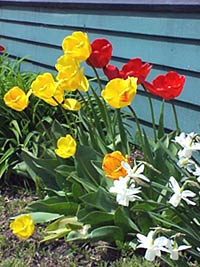
If you're like me, it's easy to feel frustrated when bulbs don't survive winter, or only leaves and no flowers appear in the spring.
I asked bulb guru Becky Heath to provide some helpful hints to get bulbs off to a good start. I learned that you can avoid many bulb problems simply by planting and fertilizing correctly.
The first requirement is planting at the right depth. In "average" loam soil, plant bulbs three to four times their height. For example, if a daffodil bulb is 3 inches tall, plant so its base is 9 to 12 inches down. In heavier, clay soils, plant 9 inches deep; in lighter, sandier soils, plant 12 inches deep.
Exposure is important, too. Bulb plants grow best when planted in full sun. However, don't calculate how much sun an area gets in early spring or in fall when any trees above them have no leaves. Determine light level in summer when the trees have leafed out. The bulb foliage grows into the summer and needs the whole season's sun to synthesize energy.
Bulbs need fertilizer, but the kind of nutrition varies with the plant. Careful research has demonstrated that tulips, hyacinths, and fritillaria are best served by a 9-9-6 formula fertilizer such as Holland Bulb Booster. Daffodils and snowdrops need nitrogen and potassium and thrive on a 5-10-20 mixture. For both fertilizers, use about 1/2 cup per 10 square feet. Sprinkle it on top of the soil after planting, not in the hole. Fertilizer in the hole may burn tender, young roots.
Fertilize established bulb beds in fall, too. All the foliage is dormant then, so it may be difficult to locate bulb beds, especially if they're naturalized. Try planting grape hyacinths (Muscari armeniacum) as indicator bulbs. They produce small blue flowers in the spring but also send up fall foliage. Plant them around the edge of the bulb area to mark your other plantings.
Another problem is rodents that eat newly planted bulbs. Repellents, such as moth flakes, spread around the area may work temporarily, but for added protection, line the planting hole with chicken wire or plastic net bags. A 1/2- to 1-inch-diameter piece of mesh hardware cloth or chicken wire is more likely to deter the rodents.
Such protective barriers are also useful when you need to lift and store tender bulbs and tubers such as gladioli, dahlias, and tuberous begonias that must be taken up each fall in northern gardens.
Photography by Suzanne DeJohn/National Gardening Association
 Charlie Nardozzi is an award winning, nationally recognized garden writer, speaker, radio, and television personality. He has worked for more than 30 years bringing expert gardening information to home gardeners through radio, television, talks, tours, on-line, and the printed page. Charlie delights in making gardening information simple, easy, fun and accessible to everyone. He's the author of 6 books, has three radio shows in New England and a TV show. He leads Garden Tours around the world and consults with organizations and companies about gardening programs. See more about him at Gardening With Charlie.
Charlie Nardozzi is an award winning, nationally recognized garden writer, speaker, radio, and television personality. He has worked for more than 30 years bringing expert gardening information to home gardeners through radio, television, talks, tours, on-line, and the printed page. Charlie delights in making gardening information simple, easy, fun and accessible to everyone. He's the author of 6 books, has three radio shows in New England and a TV show. He leads Garden Tours around the world and consults with organizations and companies about gardening programs. See more about him at Gardening With Charlie.